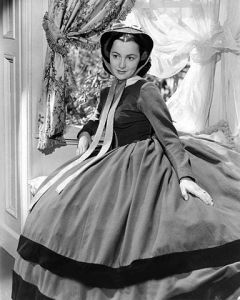Margaret Mitchell’s Gone With the Wind is one of those wonderful one book wonders. I first read it as a teenager after extracting it from a box of my mother’s books stored in a closet. My mother was not a reader of books after her marriage in January of 1943; all she had time for after that was reading the Sunday newspaper. I suspect that the last novel she may have read was another one I found in that same box and also read–A Tree Grows in Brooklyn by Betty Smith published in 1943. Mitchell’s book came out in 1936 to instant acclaim; hot on the heels of that success, the film adaptation of her 1037-page wonder was released in December 1939. I am sure that my mother joined the hordes of other movie-goers who watched David Selznick’s film for the first time, because she claimed that I was named for one of her favorite actresses–Olivia de Havilland who played Melanie Hamilton. By the way, the actress endures too; she will celebrate her hundredth birthday on July 1st of this year.
I have just finished reading Gone with the Wind for the second time. What made me tackle this jumbo novel again in my sixties? In researching the popular culture of the 1930’s in America for a novel I am in the process of writing now, I wanted to learn what books, film, songs, and events had a major impact on American society during that decade. Could it be that Scarlet’s travails to save Tara and to never be hungry or poor again paralleled the sufferings that so many Americans experienced during the Depression years? I think so, but that is only one factor that accounts for the enormous popularity of this book for which Mitchell received the Pulitzer Prize. It is unique in the field of one book wonders, because its size could very well encompass at least three individual novels: one centered on the antebellum period, one centered on the Civil War years, and one centered on the Reconstruction years. All facets of the novel–character, dialogue, description, plot–are developed skillfully and in-depth. Mitchell’s vivid description of the siege of Atlanta may not have impressed me as a teenager, but this time around, I marveled at how she made the devastation and destruction real. I felt the horror, chaos, and the panic the South experienced during General Sherman’s March to the Sea.
In the realm of novels, there have been other one book wonders: Wuthering Heights, The Bell Jar, A Confederacy of Dunces, Invisible Man, Dr.Zhivago. Until recently, Harper Lee’s To Kill a Mockingbird was considered such a wonder, and many critics after publication of Go Set a Watchman, believe it should have remained so. The untimely deaths of some of these authors, including Mitchell’s after being struck by car while crossing an Atlanta street, account for many one book wonders. Such is the case also with Emily Brontë, Sylvia Plath and John Kennedy Toole. It may also be the case that some of these authors with only one distinguished published novel to their credit have wisely consigned inferior works to the closet. Interestingly, Ralph Ellison’s second novel Juneteenth was published posthumously in 1999. A Confederacy of Dunces was published posthumously in 1980 only through the persistent efforts of Toole’s mother, who found a carbon copy of the manuscript after his suicide in 1969. After the death of a one-book-wonder author, there is always the possibility that a literary sleuth will uncover another novel hidden in a trunk. As for Plath and Boris Pasternak, they did continue to write non-fiction and poetry books.
I wonder if an author exists who wrote one great book and then went on to live a long life, vowing that one book contained all that he ever wanted to say, in contrast to the author whose production was cut short because he died too soon. That hypothetical situation seems paradoxical, for it would be rare for a person with a penchant for writing not to find more to write about in the course of a long life. After the success of The Catcher in the Rye, J.D. Salinger retreated from public life, publishing occasional short stories. His literary executors have promised more short stories and a novel to be published posthumously between 2015 and 2020, but the second novel has not appeared yet. Marcel Proust died before he completed revision of the proofs of the last three volumes of his magnum opus In Search of Time Past (a novel in 7 volumes, written over the course of the years 1909 to 1922). But is Proust’s work really one wonder or seven wonders?
My readers, can you think of any other one book wonders and comment upon them?
